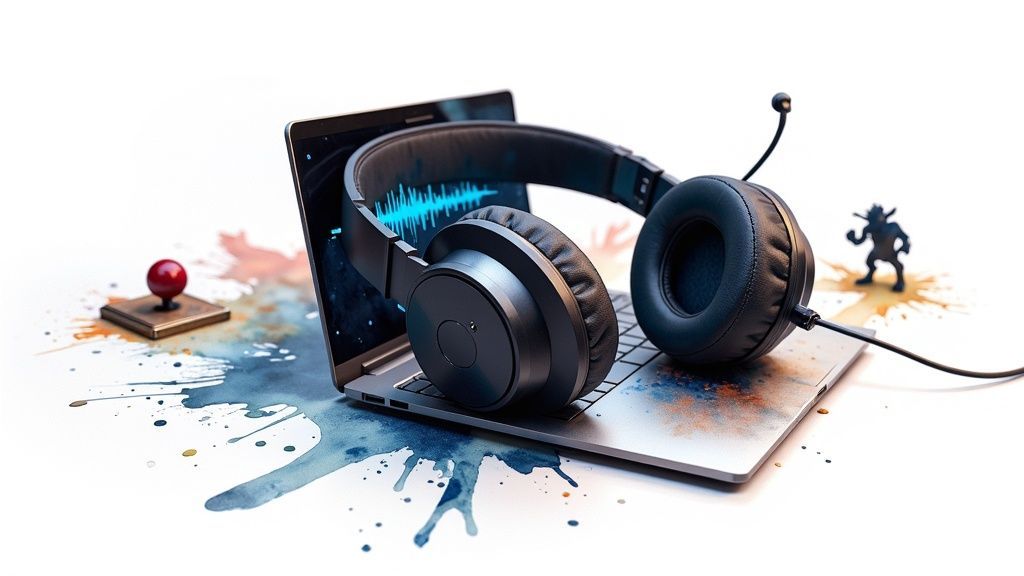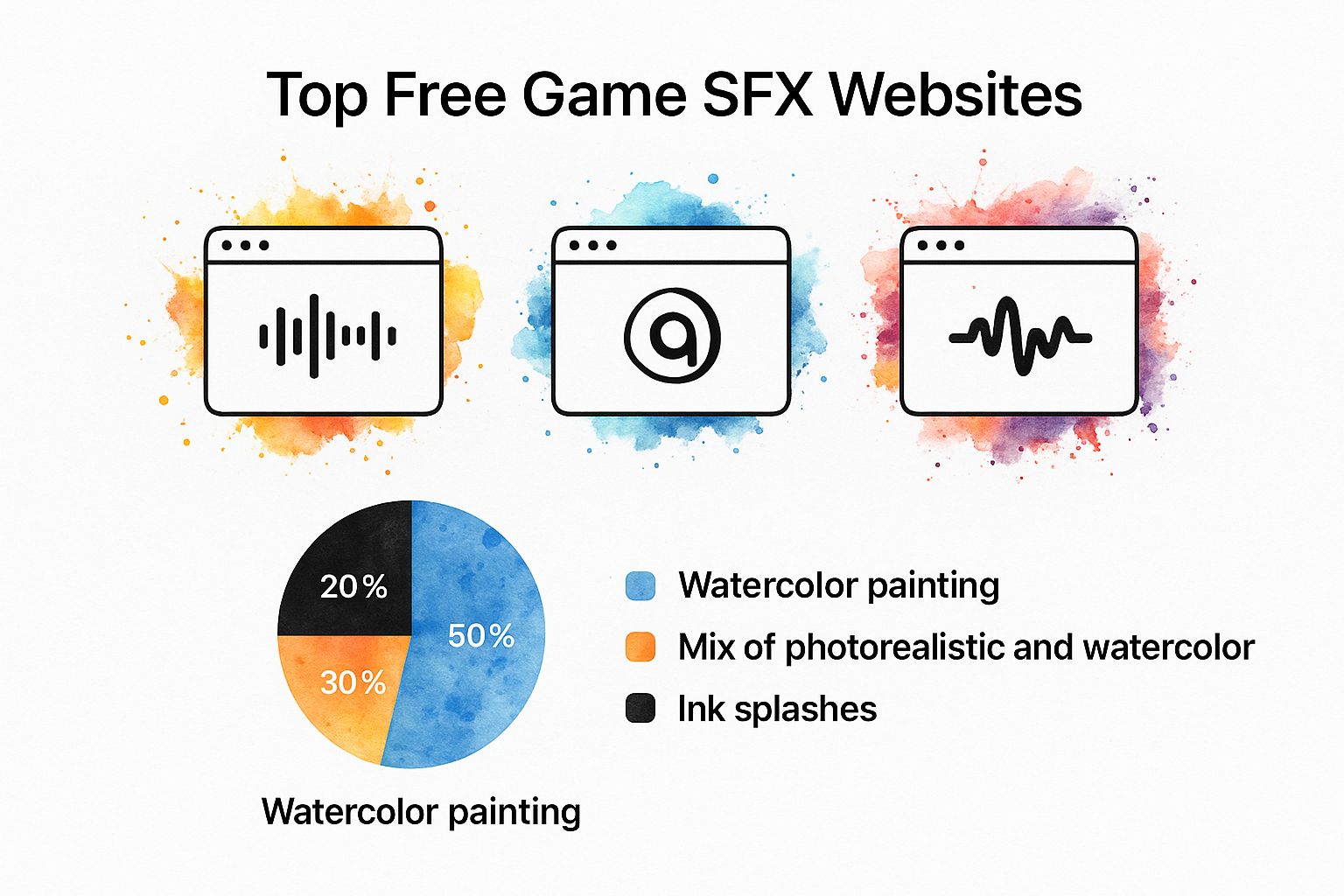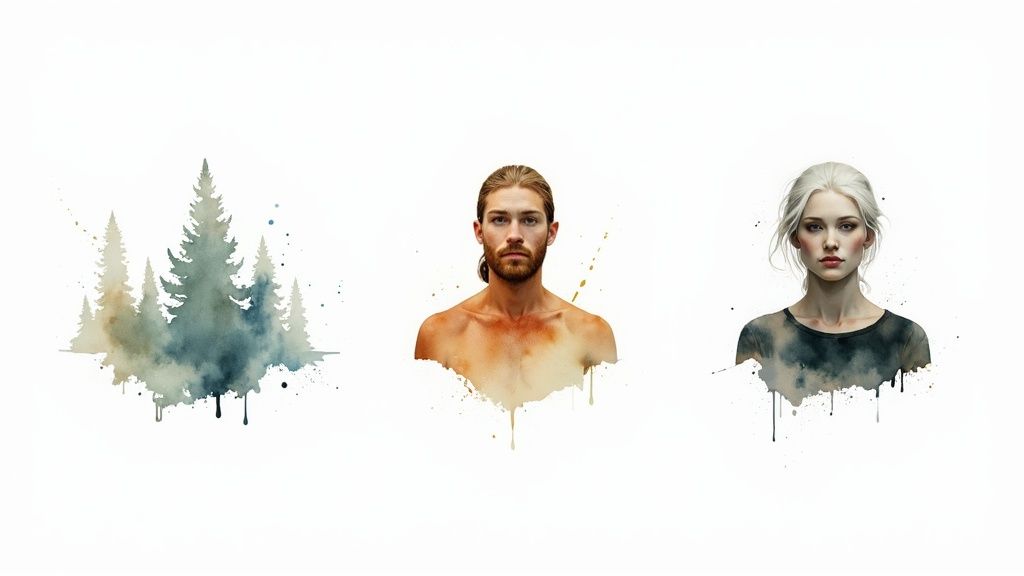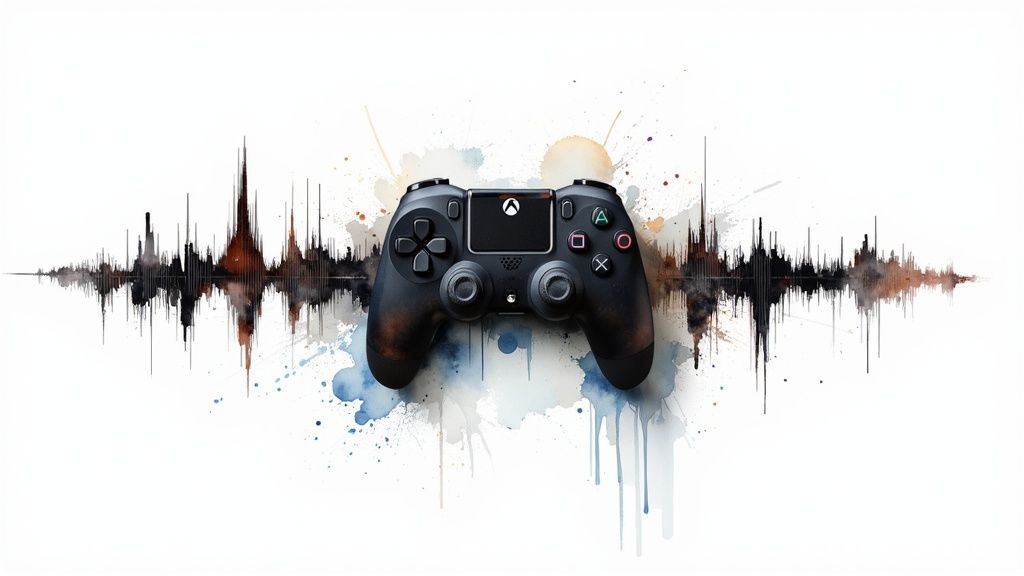
It's totally possible to find amazing, free sound effects for your game. You just need to know where to find the good stuff and how to navigate the simple licensing rules that keep your project safe and legal. For any developer, this means tapping into huge audio libraries without blowing your budget.
Let's be real for a second. Bad audio can absolutely tank an otherwise brilliant game. You can build the most visually stunning world, but without a convincing soundscape, it just feels hollow. It shatters the very immersion you've poured countless hours into creating.
High-quality sound isn't just a luxury for AAA studios anymore; it’s a fundamental part of what makes a game feel complete and professional.
Think about all those little sounds that make a game feel right. The satisfying thump of a menu selection, the specific crunch of footsteps on gravel versus the soft pad on grass, or the low hum of a sci-fi cityscape. These details aren't just background noise—they ground the player in your world, making everything feel more tangible and believable.
This isn't just a hunch; the industry data backs it up. The global game sound design market was valued at around $0.28 billion and is expected to climb to nearly $0.68 billion by 2033. This surge shows just how much demand there is for top-tier audio in games on every platform, from PC to mobile. You can dig into the numbers yourself over at Business Research Insights.
A game's audio is the invisible architecture that defines its entire mood and pace. It’s what tells a player to feel tense, to celebrate a win, or to just soak in the atmosphere you've built.
The good news? The rise of accessible tools and libraries has completely changed the game. Indie devs and solo creators can now find and generate incredible free sound effects for games, letting them compete on audio quality without needing a Hollywood-sized budget.
This access empowers you to build a soundscape that truly stands out. With the right sounds, your project gets:
Ultimately, putting real effort into your game's audio is one of the smartest investments you can make. A memorable soundscape is one of the most powerful tools you have to make your game stick with players long after they've put down the controller.
Let's be honest: the internet is swimming in "free" sound effects. But sifting through the sea of low-quality clicks and generic whooshes to find that perfect, crisp magical healing spell can feel like a quest in itself. Worse, you could unknowingly download something with a restrictive license that comes back to bite you later.
The good news is that the explosion in indie and mobile game development has fueled the rise of some truly fantastic, high-quality audio libraries. Developers on a shoestring budget now have access to sound design assets that were once out of reach. This shift has been a game-changer for solo creators and small studios. If you're interested in the market trends behind this, you can dig deeper into the growth of the game sound design market.
To get you started, here's a look at some of the best places to find free game SFX that developers actually trust.

The common thread here? These platforms are known for their curated collections and, most importantly, their crystal-clear licensing. That’s why they’ve become staples in the game dev community.
Before you hit that download button, you absolutely have to understand the license. Think of it as the sound's rulebook—it tells you exactly what you can and can't do with it. Getting this wrong can cause major legal headaches down the road.
This little table breaks down the most common licenses you'll run into. It's a quick-reference guide to help you make smart, safe choices for your project.
| License Type | What It Means | Best For | Attribution Required? |
|---|---|---|---|
| Public Domain (CC0) | No copyright. It's a free-for-all; use it however you want, no strings attached. | Any project, especially commercial games where you want zero legal hassle. | No |
| Creative Commons (CC) | A family of licenses. Some require credit, others restrict commercial use or modifications. | Projects where you don't mind giving credit. Always check the specific type (e.g., CC BY). | Often, yes |
| Royalty-Free | You get a license (even for free) to use the sound in commercial projects without paying ongoing fees (royalties). | Most commercial games. It provides flexibility, but you don't own the sound itself. | Sometimes |
For most game developers, especially if you plan to sell your game, Public Domain (CC0) and Royalty-Free are the gold standard. They give you the most freedom and the least amount of legal risk.
My Pro Tip: I learned this the hard way. Start a simple spreadsheet from day one. Log every sound you download, its source, and its license. It takes a few seconds per sound but saves you hours of panic when you’re building your credits screen and need to double-check attribution. Seriously, do it.
What happens when you can’t find the perfect sound? Sometimes, no library has exactly what you need—like the sound of a tiny crystal creature munching on a glowing mushroom or a heavy, rusted vault door groaning open in an ancient alien ruin. This is where AI sound generation really shines, giving you a way to create completely unique free sound effects for games.
Instead of spending hours digging through libraries, you can generate audio from a simple text description. With a tool like SFX Engine, you can describe what you hear in your head and let the AI build it from scratch. It’s like having an infinite audio palette for your game.
It’s a surprisingly straightforward process. You just type in what you're looking for and let the AI work its magic.

The secret sauce is learning how to write effective prompts. The more detailed and evocative your text is, the closer the AI will get to the sound you’re imagining.
Crafting a good prompt is more of an art than a science. You want to be specific, but not so rigid that you stifle the AI's creativity. Think about the sound’s texture, the environment it’s in, and the action causing it.
Here’s what I mean:
Let's try another one:
From my experience, the best AI prompts combine an action, a material, and an environment. For instance, "a metal key turning slowly in a rusty lock, inside a small, empty room" is way more effective than just "key turning."
Once you get a sound you like, you can start iterating. Maybe that monster roar needs to be deeper, or the magic spell could use more crackle. Good AI tools let you refine and regenerate until it’s perfect. If you want to dive deeper into this workflow, our guide on https://sfxengine.com/blog/how-to-create-sounds walks you through the entire process.
AI isn't just for sci-fi doors and monster growls. It's also making a huge impact on music creation, helping developers generate atmospheric scores and complex ambient tracks. It's worth exploring some of the best AI music generators to see how you can build a complete and cohesive soundscape for your game.
Having the ability to generate custom, royalty-free audio on demand is a massive advantage. It frees you from the limitations of existing libraries and helps ensure every sound in your game feels truly unique. This doesn't just save time—it elevates the quality and character of your project.
You’ve got a folder packed with awesome sound effects. That’s a fantastic starting point, but let's be real—those files are just sitting there until you bring them to life inside your game. This is where a lot of developers, even seasoned ones, can get tripped up. Getting your audio into the engine and working correctly is just as crucial as picking the perfect sound in the first place.
The first bridge to cross is audio preparation. Before you even think about dragging a file into your project, you have to decide on formats. It usually comes down to the classic WAV versus OGG debate. I almost always use WAV for short, punchy sounds that need to fire instantly—think UI clicks, gunshots, or a character's grunt. There's no decompression lag. For anything longer, like background music or ambient loops, OGG is your best friend because it dramatically shrinks the file size, keeping your game's final build lean.
Beyond just the file type, you absolutely have to normalize your audio. This just means bringing all your sounds to a consistent loudness, usually targeting somewhere between -3dB and -6dB. This simple step prevents one sound from blasting a player's eardrums while another is barely a whisper. It’s what makes a soundscape feel polished and professional.
A little bit of basic editing goes a long, long way, too.
A great soundscape feels cohesive, not like a random collection of noises. Normalizing your audio is the single most important step toward achieving that cohesion and avoiding player ear fatigue.
Once your files are prepped, getting them into the engine is usually the easy part. Both Unity and Unreal Engine have simple drag-and-drop import systems. The real craft comes in setting up the triggers.
This is where you attach an Audio Source component (or its equivalent) to a specific game object. For instance, you’d link a footstep sound to the player character's model or an explosion effect to a grenade projectile. It’s all about context.
These skills are becoming more valuable every day. While North America has traditionally been the biggest player in the game sound design market, the Asia-Pacific region is catching up fast, projected to grow at a 9.2% CAGR. This growth is fueled by the explosion in mobile gaming and new VR/AR experiences, all of which demand high-quality, responsive sound. You can dig into the game sound design market trends yourself to see just how important this is becoming.
Mastering these fundamental integration techniques isn’t just about making your game sound good; it’s about meeting the high expectations of today's players.

Even with the best intentions, a lot of developers stumble into audio traps that can really drag down an otherwise fantastic game. Finding great free sound effects for games is a solid start, but how you implement them is what truly shapes the player's experience.
One of the most obvious red flags I see is a lack of audio consistency. This is what happens when you grab sounds from all over the place without thinking about how they fit together. You end up with a crisp, modern UI click right next to a muddy, lo-fi explosion that sounds like it was ripped from a game in the 1990s. That kind of clash shatters immersion instantly.
Another killer is ear fatigue. And no, it’s not just about cranking the volume too high. It’s often caused by repetitive, grating sounds. Think of that one footstep sample looping over and over and over again. After a while, players either tune it out completely or, worse, head straight for the mute button.
Poor mixing is a subtle but deadly problem for game audio. When a massive explosion completely swallows a critical piece of dialogue, your sound design isn't doing its job. Every sound needs its own pocket to sit in, a specific place in the auditory space.
Always think about your audio in layers. Create a hierarchy where essential sounds—like dialogue or critical gameplay cues—are always clear. Ambient sounds and music should support the action, not fight it for attention.
So, how do you avoid these common pitfalls? It's about shifting your mindset.
Don't just download and drop. A random assortment of sounds will feel disconnected and amateur. Instead, curate your audio palette. Before you even think about putting a sound in your game, listen to all your effects together. Do they feel like they belong in the same world? If something sticks out, tweak its levels, apply some EQ, or find a better replacement.
Don't let every sound scream for attention. Not all audio is created equal. Prioritize your sounds based on their importance to gameplay. Use volume, panning, and effects to guide the player's focus. This turns your soundscape from simple noise into a valuable tool that enhances the experience.
Diving into the world of free audio for your game usually sparks a few questions. I see them pop up all the time, especially from developers working on commercial projects. Getting these answers straight from the start saves you a ton of headaches and keeps your project on solid legal ground.
Let's clear up some of the most common points of confusion.
This is probably the biggest one. When you see royalty-free, it means you get a license—sometimes for free, sometimes with a one-time fee—to use the sound in a commercial project without paying ongoing fees (royalties) for every copy you sell.
But here’s the catch: you absolutely must read the license. Many free assets, particularly those under a Creative Commons license, require you to credit the original creator in your game. Always check the fine print.
This one's a classic balancing act between sound quality and file size. There isn't a single "best" format; it depends on how the sound is used.
A good rule of thumb? WAV for short, crucial sounds; OGG for everything else.
Most of the time, yes. Tweaking a sound effect is a fantastic way to make it unique to your game. However, whether you're allowed to is entirely up to the license.
Before you fire up your audio editor, double-check the license for a "No Derivatives" (ND) clause. If you see that, you have to use the sound exactly as-is.
This is where AI can be a game-changer. If licensing restrictions are holding you back, a free AI sound generator lets you create something completely original from scratch, tailored perfectly to your needs without any of the licensing guesswork.
Ready to stop searching and start creating? SFX Engine gives you the power to generate endless, unique, and royalty-free sound effects with simple text prompts. Get started for free today and build the perfect soundscape for your game at https://sfxengine.com.